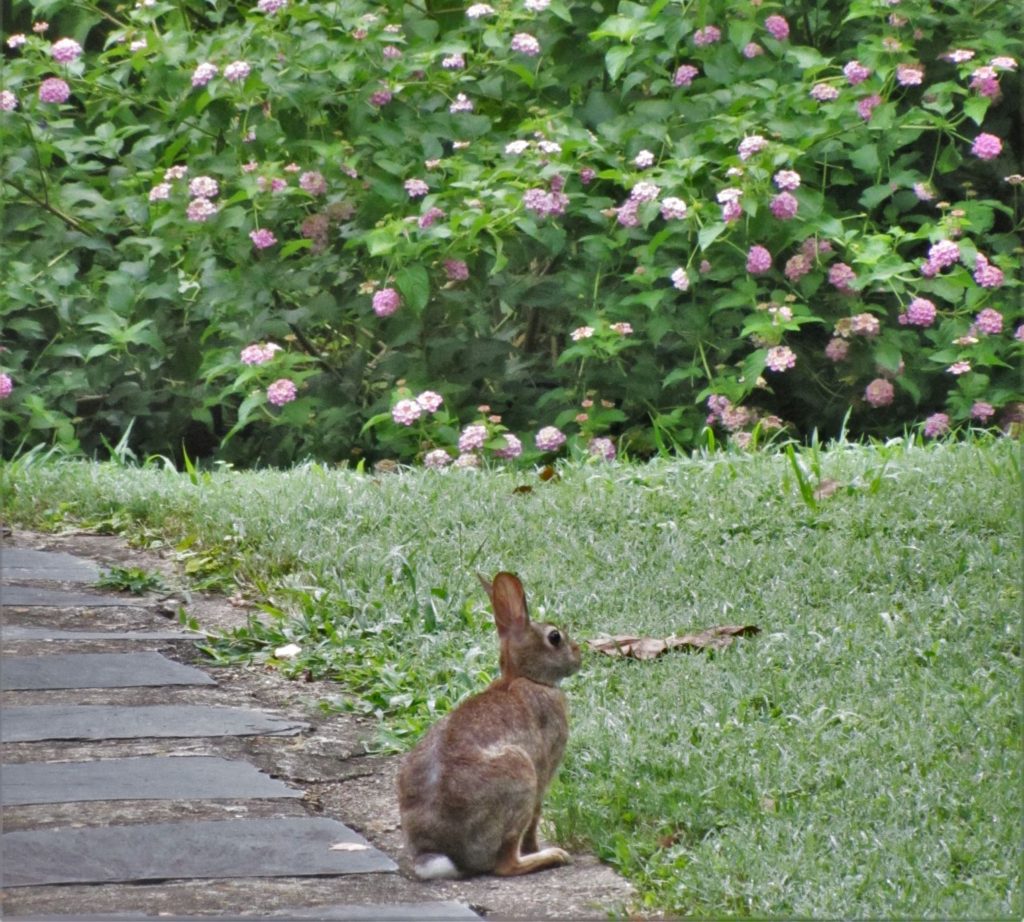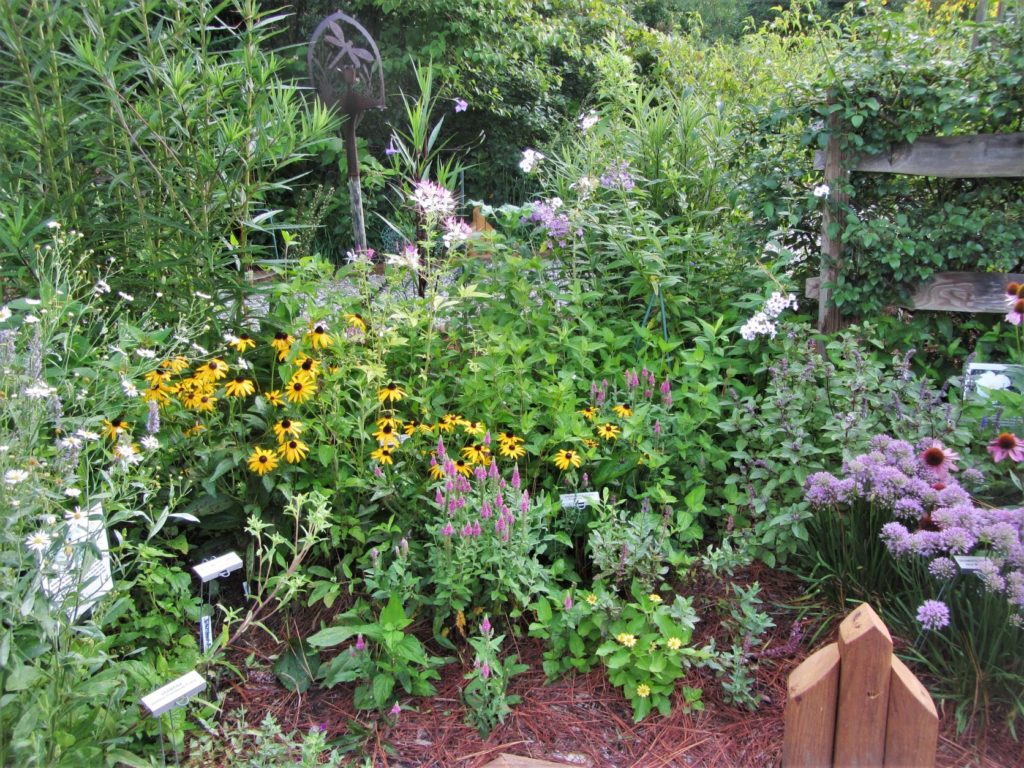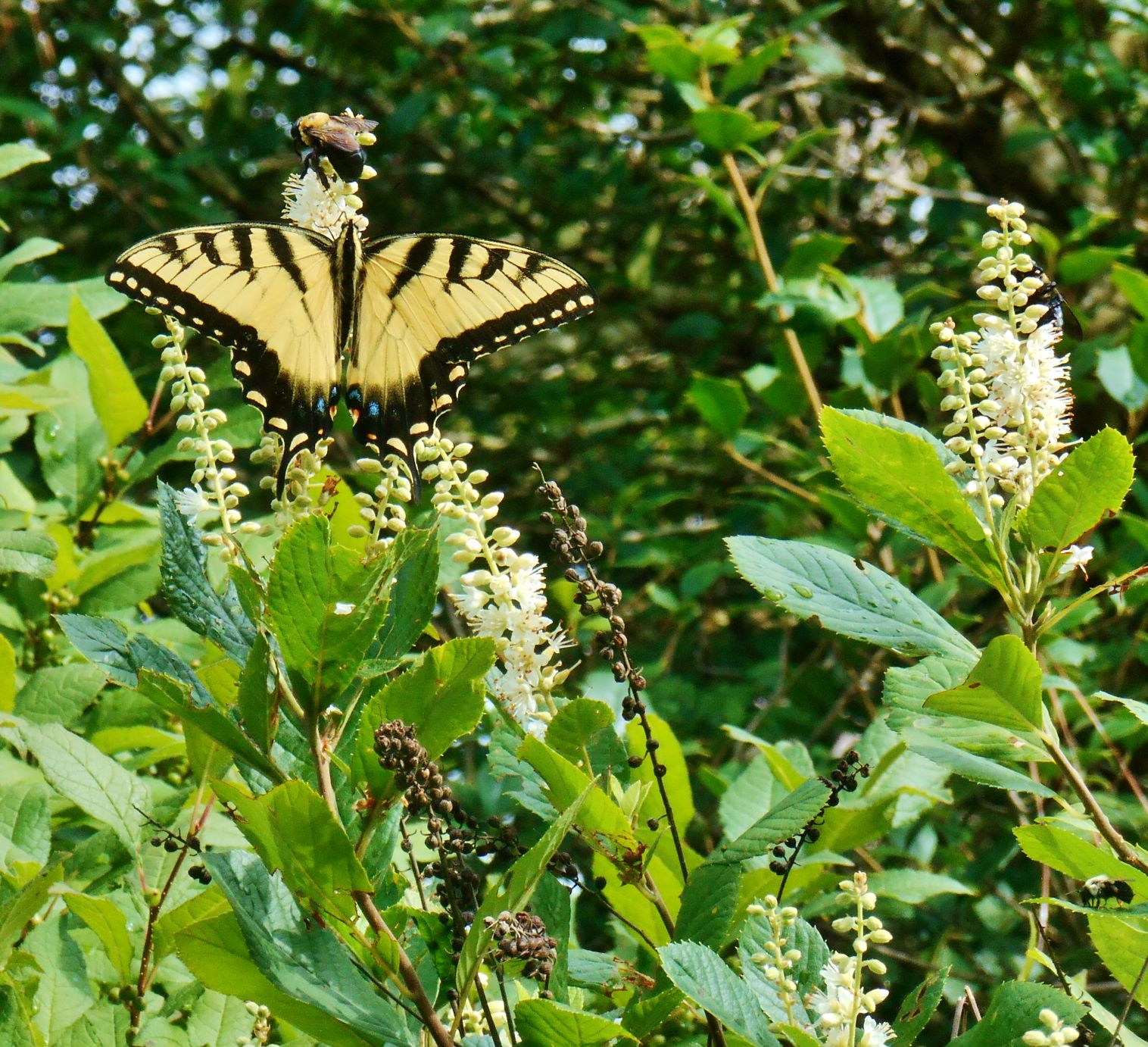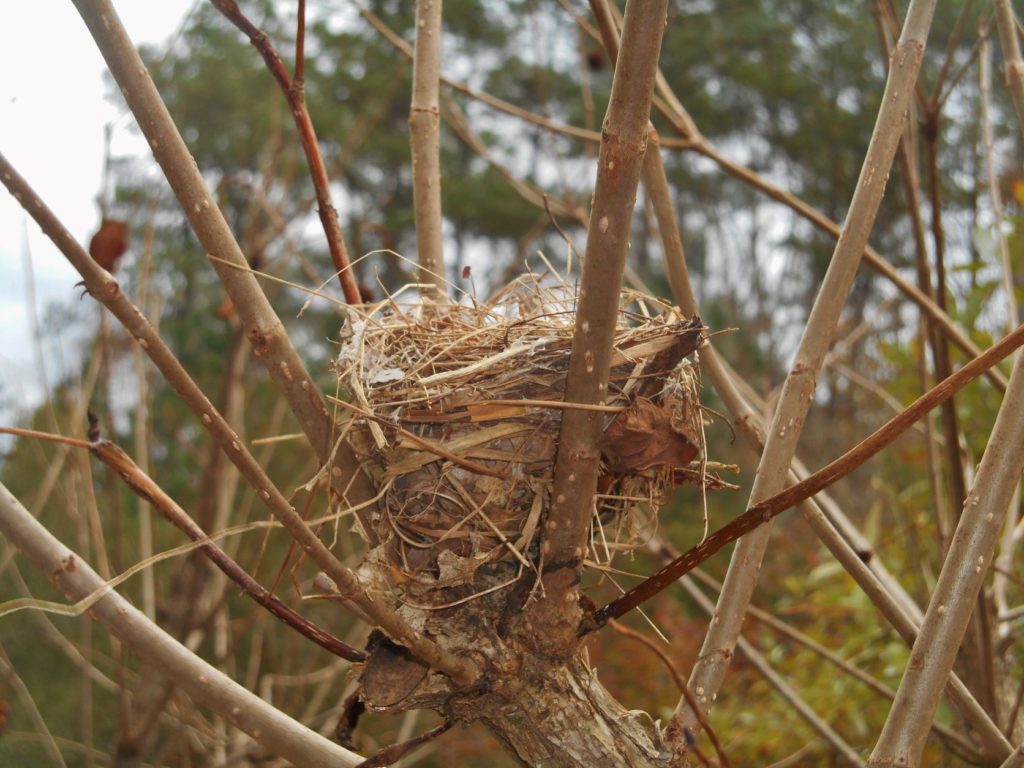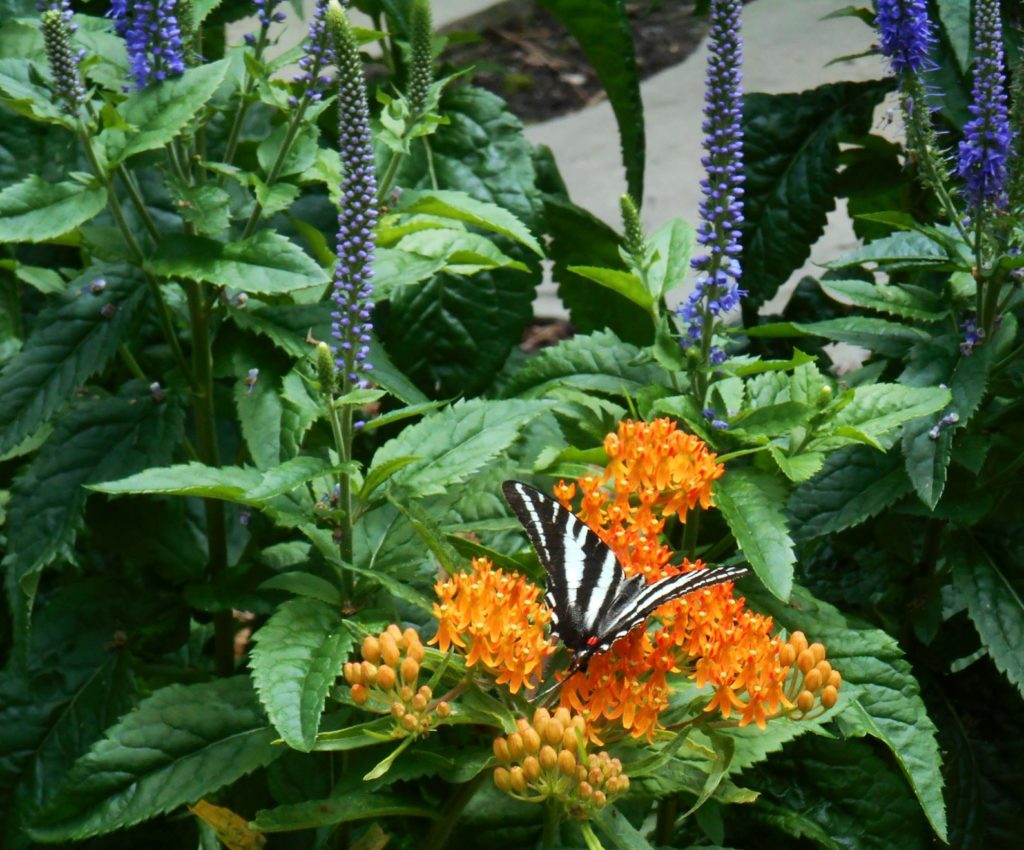Invitation to a ‘Homegrown National Park’
The bright flash of a butterfly’s wing brings instant joy. My mind clears for a moment of rapt attention to see what sort of butterfly it is. Where is it flying? Where is it feeding? Will it stay in our yard? Whatever had been churning through my mind evaporates in that moment of pure beauty.
Birdsong in the morning gently pulls me back from dreams, and we hear birds chattering and calling throughout the day, flying from shrub to tree. Sometimes a tufted titmouse lands on a hanging basket to pull loose some coco fiber for its nest. It may brush against the wind chime in its flight, startling us and itself as it flies away. But no matter, it will return soon enough to gather more.
Skinks appear as summer settles across Williamsburg, scuttling across the driveway and up the wall by our garage door. We go on alert to make sure none sneak inside. That’s a clue to watch for nesting turtles lumbering up from the lake. The same box turtles return year after year, finding food and shelter in our garden, becoming a sort of wild ‘pet’ through familiarity; like the rabbits who appear at dusk to nibble clover in the lawn.
We live in a neighborhood carved out of a forest, which backs up to a national park on one side and has several sources of water. Even so, we’ve learned to work with our land to invite and support even more species of animals, while adding color and beauty with a variety of native and non-native plants.
Recent studies have gathered overwhelming evidence that spending time with nature makes our lives better. Natural settings calm us, help our bodies heal, improve our memory and ability to think clearly, improve learning, and ease our relationships with others. Walking and working under trees and in gardens can add productive years to our lives.
You may have read about the many benefits of ‘forest bathing,’ popularized in Japan in the 1980s. Families and hikers fill our national and state parks, hungry for the peace and beauty that only wild landscapes and creatures offer. Perhaps this is a hunger to return to the more rural lifestyle of our ancestors, and a way to offset the rapid development of the wild spaces around us. Now, our public parks teem with visitors. Lines of vehicles wait for admittance to the most popular ones, with parking areas full and trash overflowing.
The land set aside for parks simply isn’t enough. It isn’t enough to meet our needs to immerse ourselves in nature, and it isn’t enough for the many species who require wild spaces to live and to multiply. As wild spaces have been carved into smaller and smaller areas, with roads, businesses and homes in between, the animals have been pushed out. The spaces are no longer large enough to support their lives. We need safe corridors for birds and butterflies (and other insects) and small reptiles, amphibians and mammals to travel between spaces in search of food, mates, and places to raise their young.
This understanding, and the catastrophic decline in so many wild animal species, led to Dr. Doug Tallamy’s proposal for a ‘Homegrown National Park’ in his 2020 book, Nature’s Best Hope: A New Approach to Conservation That Starts in Your Yard. Observing that by 2005, about 40 million acres of land in America was planted in private lawns, and that over 75% of our nation’s land is in private ownership, Tallamy hopes to inspire homeowners and business owners to transform their own private spaces to wildlife supporting habitat. By transforming even half of the area currently maintained as lawn into areas of trees, shrubs and native flowering plants, we can re-wild an area greater than what is currently set aside nationwide for parks.
When we meet animals’ basic needs for food, water, safety, places to shelter and places to breed, we can attract a huge variety of birds, butterflies and other animals to our yards. Most of these needs will be filled by appropriate planting or preservation of plant species. I say preservation, because older native trees, like oaks and pines, have the greatest impact for the most species of wildlife.
A white oak hosts over 400 species of Lepidoptera, and so is considered a ‘keystone species’ in our area. All the Vaccinium species in our area, the blueberries, deer berries and huckleberries, support over 200 species of Lepidoptera and 14 species of native bees. A single planting serves hundreds of different animals.

Blueberries, and other Vaccinium species feed hundreds of species of wildlife from their leaves, flowers, and drupes.
Roughly 10 woody genera, and another 10 herbaceous flowering perennials native to our region, serve as the ‘keystone’ plants, supporting the majority of native Lepidoptera and native specialist bees, according to the National Wildlife Federation. Most of these later produce nuts, drupes, or other seeds consumed by many different species. One tree can make a difference. But herbaceous perennials need to grow in larger clumps. A single plant will rarely provide enough forage to make a difference.
According to Dr. Tallamy, just 14% of our native plants support 90% of the caterpillars. Rather than always looking at ‘native plants v. non- native plants,’ we need to look at ‘productive native plants v. everything else.’ He acknowledges that about 86% of our native plant species don’t do very much to support insects, and so aren’t supporting that crucial layer of the food web.

Parsley, fennel, dill, and other plants in their Apiaceae family will support many Swallowtail larvae.
We are mainly concerned about providing native plants to serve as hosts for caterpillars and other insects, and to provide nectar and pollen to specialist native bees. Of course, there is value in preserving our native plants for their own sake. Allowing them space to grow and reproduce in our gardens is a first step.
For example, the simple violets growing in our lawns, the Viola culcullata, serve as hosts to Fritillary butterfly larva and support several species of native, specialist bees with their flowers. Rather than weeding them out, we can appreciate their beauty and function in the landscape. That is a hard lesson I’ve learned in recent years as I’ve come to recognize more ‘mystery plants’ cropping up in our yard as valuable native wildflowers. Specialists, like the Monarch butterfly, depends on the single genus Asclepias as its only host plant. While they may nectar at a variety of flowers, their larvae require milkweed to develop. “Plant it, and they will come.”
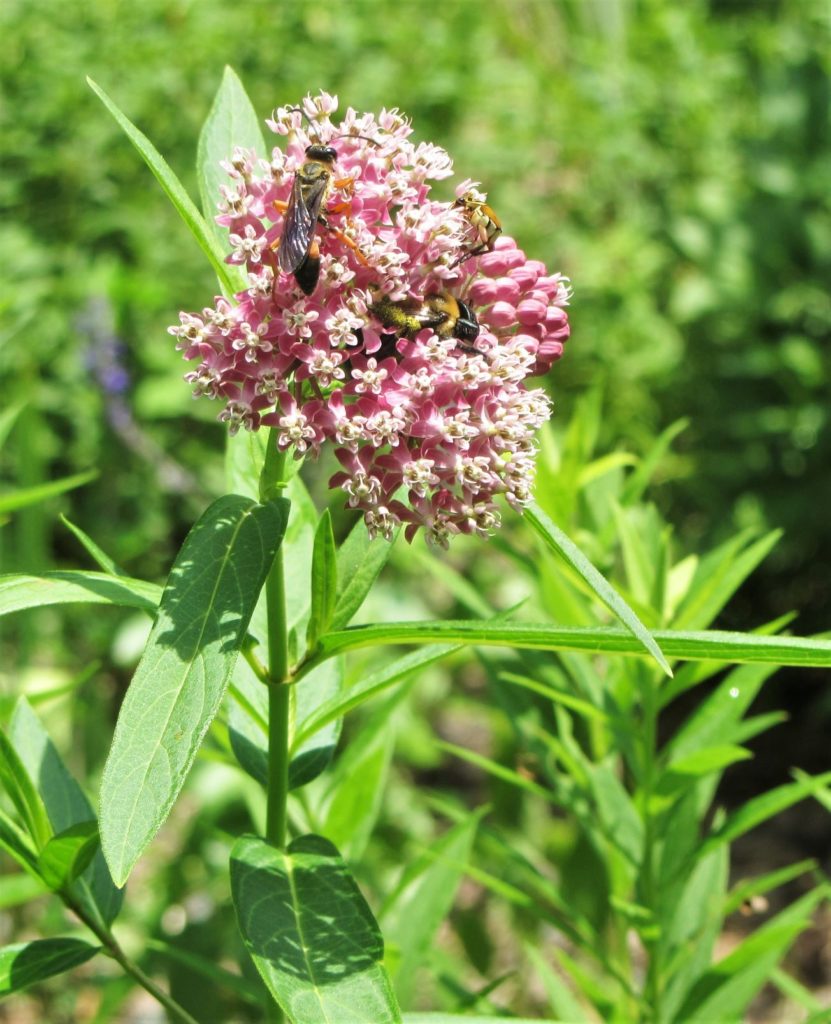
Asclepias syriaca, common milkweed, hosts Monarch larvae and provides nectar to many other pollinators.
Allowing wildflowers and a variety of grasses to co-exist in a ‘bee-lawn’ further reduces the negative impacts of sterile lawn in our neighborhoods. Most lawn grasses are imported species which don’t support wildlife. Many of us love the elegance and convenience of a lawn, but they invite use of fertilizers and herbicides that accumulate in the soil and in our waterways, and require noisy, exhaust producing maintenance. Slow growing grasses, sedges and low growing flowering perennials can still provide the expanse of green many of us crave, while returning some benefit to the environment.
Dr. Tallamy invites us to evaluate plants based on their function, rather than solely on their aesthetic. If a non-native plant functions to support wildlife, we can incorporate it and enjoy it. He advises that our residential landscape should support the local web of life and support pollinators while also helping to sequester carbon and manage the watershed to minimize run-off. When we provide a diversity of flowering plants to meet the needs of specialists as well as generalists, we invite an ever-increasing variety of animal life into our outdoor spaces. We also do our part to help improve water and air quality where we live.
“Everything you do on your property affects the rest of the planet-either negatively or positively,” in Dr. Tallamy’s view. We can accept his challenge to maintain the properties we can directly influence in the spirit of a ‘Homegrown National Park.’ This may involve removing invasive and non-productive plants to make room for more functional ones. It may mean planting more woody species to provide shelter for wildlife and provide spaces to nest or deposit their eggs. Native trees will also manage rainfall and sequester carbon. It may mean choosing flowering plants because they host certain endangered butterflies, not because we like their color or form.
At the same time, gardens are cultivated spaces for people, and we must keep health and safety in mind, as well as the rules of our HOAs and the expectations of our neighbors. Maybe we don’t plant an oak tree where it might fall on the house in a future storm. We maintain clear space around our home’s foundation and don’t allow branches to grow onto our roofs. There are paths and places to sit. Our wildflower plantings look curated and cared for, and we remain mindful of those species we might not want to attract, like ticks and poisonous snakes. There is always a balance to maintain.
Our rewards for stewardship are great. We have the satisfaction of making a positive difference against some of the most intractable problems of our time. And we have the simple pleasures of living in beauty, with the company of the wild things that appear to share our outdoor spaces. The peace and happiness they bring enriches our lives in many unpredictable ways, and we enjoy the benefits of park lands at home.
These Keystone plants support 90% of Lepidoptera larvae and provide pollen for specialist bees in our Eastern Temperate Forest region. Find more information
Keystone Woody Genera Keystone Herbaceous Genera
Acer Bidens
Betula Chrysopsis
Carya Coreopsis
Malus Grindelia
Pinus Heterotheca
Populus Helianthus
Prunus Rudbeckia
Quercus Solidago
Salix Symphyotrichum
Vaccinium Verbesina
Further Resources:
Beuerlein, Scott. “Douglas Tallamy- Nature’s Champion Has a Message of Hope for Horticulturalists.” Horticulture Magazine. March/April 2022. pp. 20-22.
Darke, Rick and Douglas Tallamy. The Living Landscape: Designing for Beauty and Biodiversity in the Home Garden. 2014.
Tallamy, Douglas. Bringing Nature Home: How Native Plants Sustain Wildlife in Our Gardens. 2007.
Tallamy, Douglas. Nature’s Best Hope: A New Approach to Conservation That Starts in Your Yard. 2020.
Tallamy, Douglas. The Nature of Oaks: The Rich Ecology of Our Most Essential Native Trees. 2021.
Purpura, Mary. “Your Piece of the Park.” Horticulture Magazine. March/April 2022. pp. 24-26.
All Photos by E. L. McCoy


